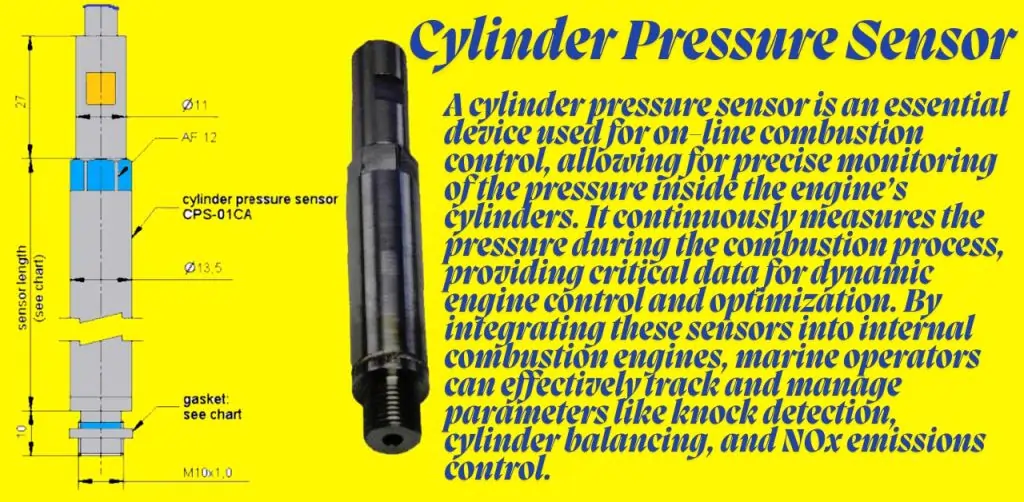Ensuring the safety, efficiency, and performance of marine engines is crucial in the maritime industry. A reliable and precise tool for monitoring and optimizing engine performance is the Cylinder Pressure Sensor. This advanced sensor technology plays a pivotal role in real-time combustion control on diesel and gas engines, ultimately enhancing engine performance, reducing emissions, and improving safety. Whether for knock detection, cylinder balancing, or NOx control, the cylinder pressure sensor offers a sophisticated solution to modern engine management systems.
What is a Cylinder Pressure Sensor?
A cylinder pressure sensor is an essential device used for on-line combustion control, allowing for precise monitoring of the pressure inside the engine’s cylinders. It continuously measures the pressure during the combustion process, providing critical data for dynamic engine control and optimization. By integrating these sensors into internal combustion engines, marine operators can effectively track and manage parameters like knock detection, cylinder balancing, and NOx emissions control.
The sensor’s ability to measure and relay data in real-time ensures that engine parameters remain within optimal ranges, reducing wear and tear while improving fuel efficiency and minimizing harmful emissions.
Key Applications of the Cylinder Pressure Sensor
The cylinder pressure sensor is an integral component for various engine performance optimizations. Here are the primary applications where this sensor is used:
- Knock Detection: Identifying and preventing engine knock, which can damage the engine, is vital for engine health. The sensor ensures the combustion process is stable, preventing abnormal combustion events that could lead to knocking.
- Cylinder Balancing: Cylinder balancing involves adjusting the combustion process in each cylinder for optimal performance. The cylinder pressure sensor ensures that each cylinder operates at peak efficiency.
- MIP (Mean Indicated Pressure) Calculation: This sensor aids in the calculation of mean indicated pressure, which is an important factor in understanding engine load and efficiency.
- Start of Combustion Monitoring: By detecting the precise moment combustion begins, this sensor helps optimize engine start-up performance.
- NOx Control: The sensor helps monitor and control NOx emissions, ensuring compliance with environmental regulations while maintaining optimal engine performance.
Technical Specifications of the Cylinder Pressure Sensor
The cylinder pressure sensor offers robust features, making it ideal for demanding marine environments:
- Measuring Range: 0 – 300 bar
- Overload Pressure (Static): 1200 bar (1500 bar)
- Dynamic Overpressure: Max. 5000 bar/ms
- Load Cycles: ≥ 108
- Frequency Range: 2 kHz
- Thermal Shock (1500 RPM, pmi = 10 bar): ≤ + /- 0.5 bar
- Max Temperature at Measuring Cell: 3000°C (short time 1 min, 3500°C)
- Max Temperature at Pins on Ceramic: 3500°C
- Max Temperature of Cable (Between Sensor Head and SCU): 2000°C
- Temperature Range SCU: -400°C to 750°C
- Supply Voltage: 18 – 32 VDC
- Output Signal Pressure: 4 – 20 mA
- Electric Connector: HTOE10-6P-F42-A34-SPL according to MIL-C-26482
- Thread: M10 x 1
- Type of Protection: IP 67
- Sensor Dimensions: 52 mm (122 mm), Ø 13.5 mm
- Electronic Dimensions: 115 x 18 mm
- Tightening Torque: 15 Nm
- Weight (Including Electronic): 150 g
These advanced technical specifications ensure the sensor can endure extreme conditions, making it suitable for marine engines that operate under high-stress and variable environments.
Mounting the Cylinder Pressure Sensor
To ensure accurate and reliable readings, the cylinder pressure sensor should be installed as close to the combustion chamber as possible. The installation position depends on the engine speed, with the length of the pressure bore between the sensor and the combustion chamber being a key consideration.
There are typically two options for sensor mounting:
- Head Mounted: The sensor is directly mounted on the engine’s cylinder head, providing precise measurements close to the combustion process.
- Set-Back Mounted: The sensor is mounted further back, which may be necessary for certain engine configurations.
Optimum Sensor Life and Performance
To achieve optimal sensor life and performance, it is important to maintain the average temperature at the measuring element between 200°C to 250°C. With proper usage, the cylinder pressure sensor can offer a life expectancy of over 16,000 hours when used in gas engines at 1500 rpm.
Conclusion
The Cylinder Pressure Sensor is a game-changer for marine engine safety and performance. By providing real-time combustion control and enabling precise monitoring of vital engine parameters, it helps ensure that marine engines operate at maximum efficiency and safety. From knock detection to NOx control, this sensor is an indispensable tool for modern engine management, offering enhanced performance, reduced emissions, and a longer engine life.
Investing in cylinder pressure sensors and integrating them into your engine control systems is a smart move for anyone looking to optimize their marine operations, reduce costs, and meet environmental standards. As marine technology continues to evolve, this sensor plays a crucial role in keeping engines running smoothly and efficiently.
